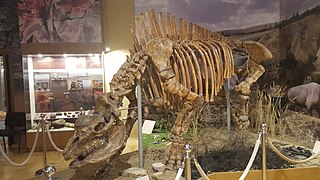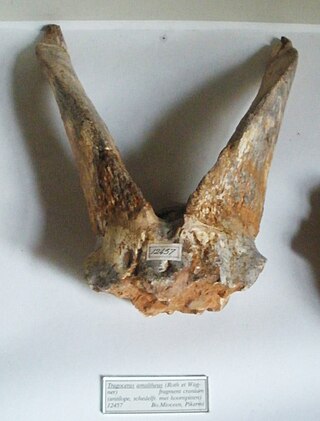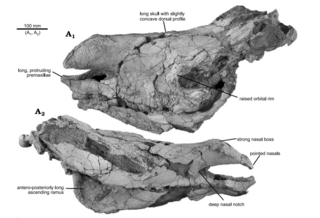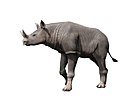
Elasmotherium is an extinct genus of large rhinoceros endemic to Eastern Europe and Central Asia with isolated finds from East Asia during Late Miocene through to the Late Pleistocene, with the youngest reliable dates around 39,000 years ago. It was the last surviving member of Elasmotheriinae, a distinctive group of rhinoceroses separate from the group that contains living rhinoceros (Rhinocerotinae).

A rhinoceros, commonly abbreviated to rhino, is a member of any of the five extant species of odd-toed ungulates in the family Rhinocerotidae; it can also refer to a member of any of the extinct species of the superfamily Rhinocerotoidea. Two of the extant species are native to Africa, and three to South and Southeast Asia.

The Indian rhinoceros, also known as the greater one-horned rhinoceros, great Indian rhinoceros, or Indian rhino for short, is a rhinoceros species native to the Indian subcontinent. It is the second largest extant species of rhinoceros, with adult males weighing 2.07–2.2 tonnes and adult females 1.6 tonnes. The skin is thick and is grey-brown in colour with pinkish skin folds. They have a single horn on their snout that grows to a maximum of 57.2 cm (22.5 in). Their upper legs and shoulders are covered in wart-like bumps, and aside from the eyelashes, ear fringes and tail brush, Indian rhinoceroses are nearly hairless.

Teleoceras is an extinct genus of rhinocerotid. It lived in North America during the Miocene and Pliocene epochs during the Hemingfordian to the end of Hemphillian from around 17.5 to 4.9 million years ago. It grew up to lengths of 13 feet long.

Diceros is a genus of rhinoceros containing the extant black rhinoceros (Diceros bicornis) and several extinct species.

Dicerorhinus is a genus of the family Rhinocerotidae, consisting of a single extant species, the two-horned Sumatran rhinoceros, and several extinct species. The genus likely originated from the Late Miocene of central Myanmar. Many species previously placed in this genus probably belong elsewhere.

Rhinoceros is a genus comprising one-horned rhinoceroses. This scientific name was proposed by Swedish taxonomist Carl Linnaeus in 1758. The genus contains two species, the Indian rhinoceros and the Javan rhinoceros. Although both members are threatened, the Javan rhinoceros is one of the most endangered large mammals in the world with only 60 individuals surviving in Java (Indonesia). The word 'rhinoceros' is of Greek origin meaning "nose-horn".

Paraceratherium is an extinct genus of hornless rhinocerotoids belonging to the family Paraceratheriidae. It is one of the largest terrestrial mammals that has ever existed and lived from the early to late Oligocene epoch. The first fossils were discovered in what is now Pakistan, and remains have been found across Eurasia between China and the Balkans. Paraceratherium means "near the hornless beast", in reference to Aceratherium, the genus in which the type species P. bugtiense was originally placed.

Ancylotherium is an extinct genus of the family Chalicotheriidae, subfamily Schizotheriinae, endemic to Europe, Asia, and Africa during the Late Miocene-Early Pleistocene, existing for approximately 9.8 million years.

Amphicyon is an extinct genus of large carnivorans belonging to the family Amphicyonidae, subfamily Amphicyoninae, from the Miocene epoch. Members of this family received their vernacular name for possessing bear-like and dog-like features. They ranged over North America, Europe, Asia, and Africa.

Adinotherium is an extinct genus of toxodontid, large bodied hoofed ungulates which inhabited South America during the Middle to Late Miocene, from 17.5 to 6.8 Ma and existed for approximately 10.7 million years, Santacrucian to Huayquerian in the South American land mammal ages (SALMA). Fossils of Adinotherium have been found in the Santa Cruz and Ituzaingó Formations of Argentina and the Chucal and Río Frías Formations of Chile.

Aphelops is an extinct genus of hornless rhinocerotids endemic to North America. It lived from the Middle Miocene to the early Pliocene, during which it was a common component of North American mammalian faunas along with Teleoceras.

Enhydriodon is an extinct genus of mustelids known from Africa, Pakistan, and India that lived from the late Miocene to the early Pleistocene. It contains nine confirmed species, two debated species, and at least a few other undescribed species from Africa. The genus belongs to the tribe Enhydriodontini in the otter subfamily Lutrinae. Enhydriodon means "otter tooth" in Ancient Greek and is a reference to its dentition rather than to the Enhydra genus, which includes the modern sea otter and its two prehistoric relatives.

Hoffstetterius is an extinct genus of toxodontid notoungulate mammal, belonging to the subfamily Toxodontinae whose remains were discovered in the Middle to Late Miocene Mauri Formation in the La Paz Department in Bolivia. The only described species is the type Hoffstetterius imperator.
Sivapanthera is a prehistoric genus of felid described by Kretzoi in 1929. Species of Sivapanthera are closely related to the modern cheetah but differ from modern cheetahs by having relatively longer brain cases, flatter foreheads, narrower nostrils and larger teeth. In many ways, skulls of Sivapanthera show similarity to that of the puma, or even those of Panthera. Scholars differ on the validity of this genus, while some think that it should be treated as a distinct genus, others think that its members should be treated as members of the Acinonyx genus, or even as subspecies of Acinonyx pardinensis.

Sivaelurus is a fossil genus of felid containing only a single species, S. chinjiensis, which was described based on a partial right maxilla collected from the Chinji Formation in the Lower Siwaliks. The species was originally described by Guy Ellcock Pilgrim as Pseudaelurus chinjiensis in 1910, who later erected a new genus, Sivaelurus, for it in 1913.

Tragoportax is an extinct genus of bovid ungulate. It lived during the upper Miocene, and its fossils have been found in Europe, Asia and Africa. Tragoportax is sometimes considered to have been a close relative of the extant nilgai, though it may have formed its own subfamily, along with Miotragocerus.

Eoazara xerrii is a species of extinct elasmotheriine rhinoceros from the upper Miocene of Morocco, the first definitive representative of the subfamily in North Africa. It is known from a well preserved skull and postcranial material, preserving the most complete late Miocene rhino skull found in Africa.
Vishnufelis is a fossil genus of feline (cat) containing only a single species, Vishnufelis laticeps. It was described by Guy Ellcock Pilgrim in 1932, based on the first cranial material of a cat found in Asia: a fragmented skull found in the Chinji Formation, which dates back to the middle Miocene.
Vinayakia is a fossil genus of proailurine felid with three species: Vinayakia nocturna, the type species, Vinayakia intermedia, and Vinayakia sarcophaga. All three species were based on fossils collected from the Miocene-aged Nagri and Chinji Formations of the Siwaliks in India and Pakistan.



























